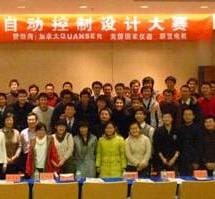
Dr. Daniela Constantinescu of the University of Victoria in British Columbia is a talented engineering educator who is able to bring a number of cross-disciplinary engineering areas to bear on her research. Her background in mechatronics, mechanical engineering, robotics and electrical engineering has allowed her to progress research projects centering on haptics.
One of her areas of interest is full-body 6 DOF interaction in a virtual environment; another more recent project involves haptic tele-cooperation. This latter area is being realized as a far-reaching rehabilitation project designed to help solve a growing real-world problem: how to ensure out-patient rehabilitation clients continue to perform their regular rehab program once they’ve returned home, with no direct engagement with rehabilitation center staff. The need for a solution is a given since the potential cost savings to individuals or the health care system could be enormous.
Challenge
Locating reliable tools to advance haptic rehabilitation research
Dr. Constantinescu envisioned a cooperative haptic exercise in which two patients with similar rehab programs could work together from their respective homes using small, low-cost rehab robots connected via the internet. “It’s almost like having a Facebook exercise group, with the two people doing their rehab exercises together online,” she said. “They would have a virtual environment on screen and be able to feel what each other was doing.”
Their rehab regimen would involve shared exercises that could only be completed by the two of them working in tandem. Their sense of responsibility to the other would help ensure the exercises were completed correctly and on schedule.
“Our technical challenge was two-fold. First, we had to find reliable 6 DOF haptic devices that would allow me and my team to conduct the research and engage in a wide range of exercise motions. Second, we needed to source control design software that would enable us to quickly and efficiently design a reliable controller for this co-operative activity.”
Solution
Quanser's Haptic Wand and QUARC software enable a solution
Dr. Constantinescu researched three different haptic systems. “I spoke with people who had these devices in their labs and discovered that those who used Quanser’s Haptic Wand were extremely pleased with their equipment.” It seems the other haptic devices didn’t come with complete manu-facturer-supplied performance guidelines, which reduced their value and dependability in Dr. Constaninescu’s view.
“Quanser supplied solid performance information about their Haptic Wand, including the accurate dynamics of the device, the achievable control stiffness, access to the low-level control of the device, and so on. Choosing Quanser’s haptic wand was pretty simple under the circumstances. Reliable and offering 6DOF interaction, it was clearly the best available device for us.”
An equally vital part of the solution was QUARC, Quanser’s control design software, and the API that Quanser provides with the Haptic Wand, because designing a controller quickly was important to the timely completion of the project.
“QUARC interfaces very easily with Simulink. It’s excellent in terms of rapid prototyping and it’s also very good in terms of research work where you have students working through Simulink. It forces the students to be in some ways better programmers than they are. Let’s face it, some mechanical engineers don’t necessarily like writing code, but now they have this ability to generate real-time code by basically developing a Simulink model and then compiling it into real time code. Students can also implement new algorithms fast because they do not need to develop their own haptic system, but only to integrate additional blocks into an existing Simulink model. That certainly makes life much easier.”
The other area that QUARC made easy for Dr. Constantinescu was the communication with her C++-based simulation engine. “That’s the other challenge when you have mechanical engineering students who do not want to spend too much time on programming – the communication between the different pieces of software is really important. If you have a virtual environment you can visualize it using MATLAB, but the physics engine to generate the dynamics of a virtual world is missing in MATLAB. For that you need a simulation package. I use the QUARC API to communicate with my virtual environment.”
Result
An on-line haptic rehabilitation community is on the horizon
Getting back to the rehabilitation exercise: what did Dr. Constantinescu’s solution ultimately consist of? “You and several users see a virtual environment on the screen with objects in it,” she says. “When you hold the Haptic Wand, you’re virtually holding one of the on-screen objects. As you move the wand, you’re moving the object and building forces and torque. The other users may help or impede your action. That translates into a cooperative action in a given rehabilitation exercise.”
Once you can do programmable force feedback, you can then adjust the outpatient program to enable users with various physical abilities to cooperate on a given exercise. As she puts it, “The resistance can be increased or decreased, the range and speed of the motion can be adjusted, and other changes can be implemented to make the exercise harder or easier for one or another of the participants, and to allow them to contribute equally to the successful completion of the exercise regardless of their different physical capacities. Best of all, we can make this adjustment on the fly, in real time! That’s due to QUARC’s rapid prototyping capability, which I really appreciate.”
“By enlarging the number of users who can perform a therapy exercise together, we will enable the development of on-line communities which support users to persist in the therapy, much like running clinics support their members to continue in their fitness program,” continues Dr. Constantinescu.
Dr. Constantinescu’s research is continuing, and relying in great part on the precision and functionality of QUARC and the Haptic Wand. But the significance up to this point is that people will be able to cooperate on full 6DOF tasks in a virtual haptic environment, not just point interaction tasks. They will now be free to manipulate anything in a virtual environment together with other remote users.
“This opens up an area that I call ‘scalable haptics’. It is based on the Facebook community idea I mentioned earlier and involves several participants who can come and go at will. It also assumes that haptic devices will be easily affordable – perhaps $200 each. Future development should occur in the home rehabilitation area, individually or cooperatively; it could also go in an entirely different direction, such as serious entertainment and games.”


